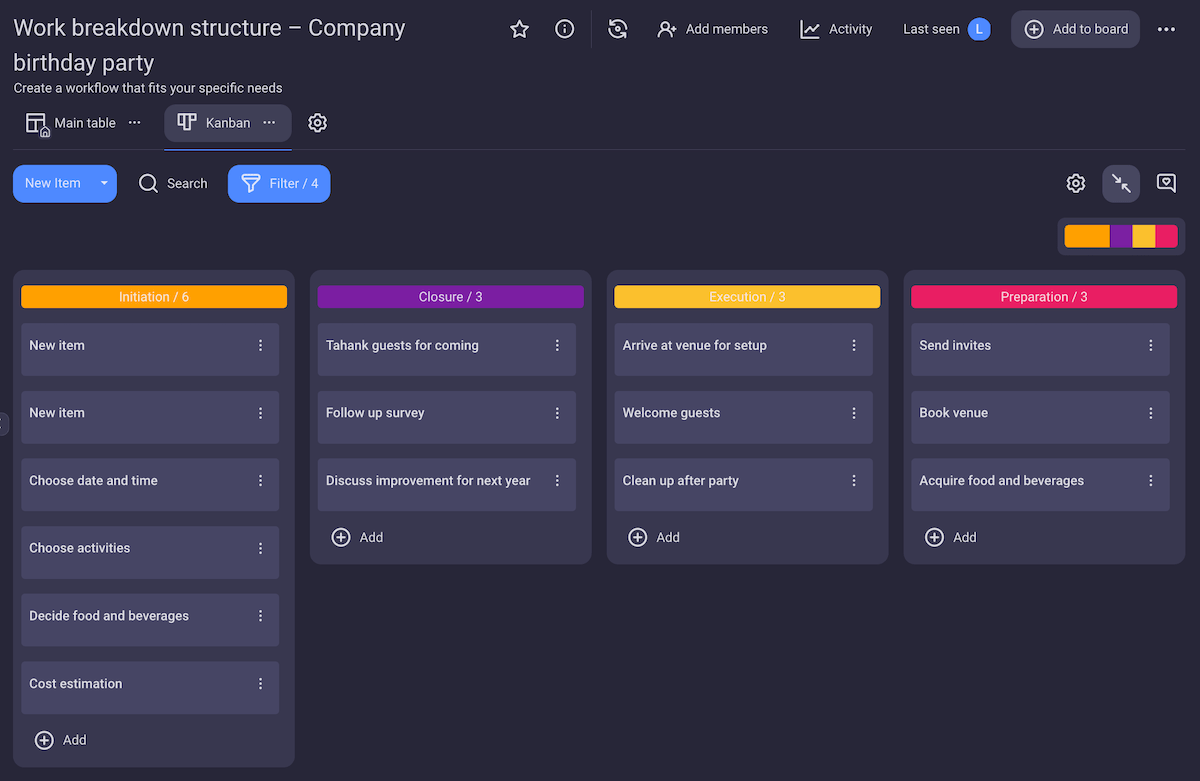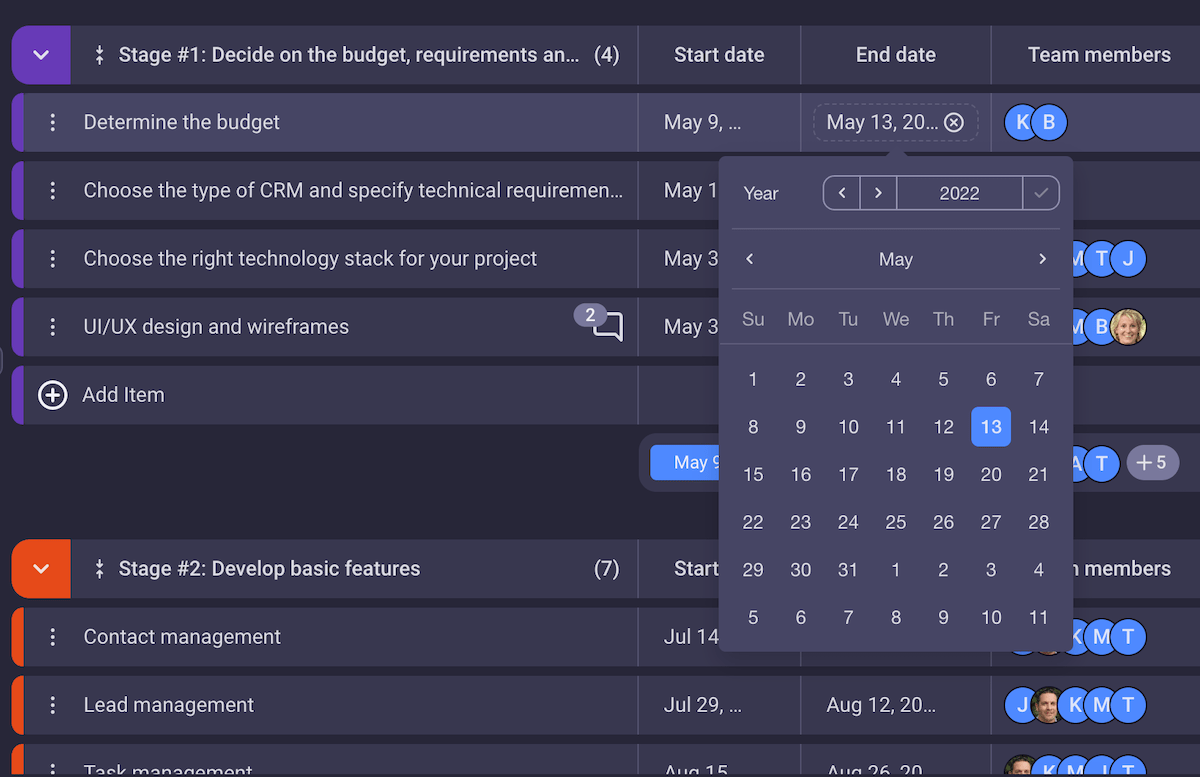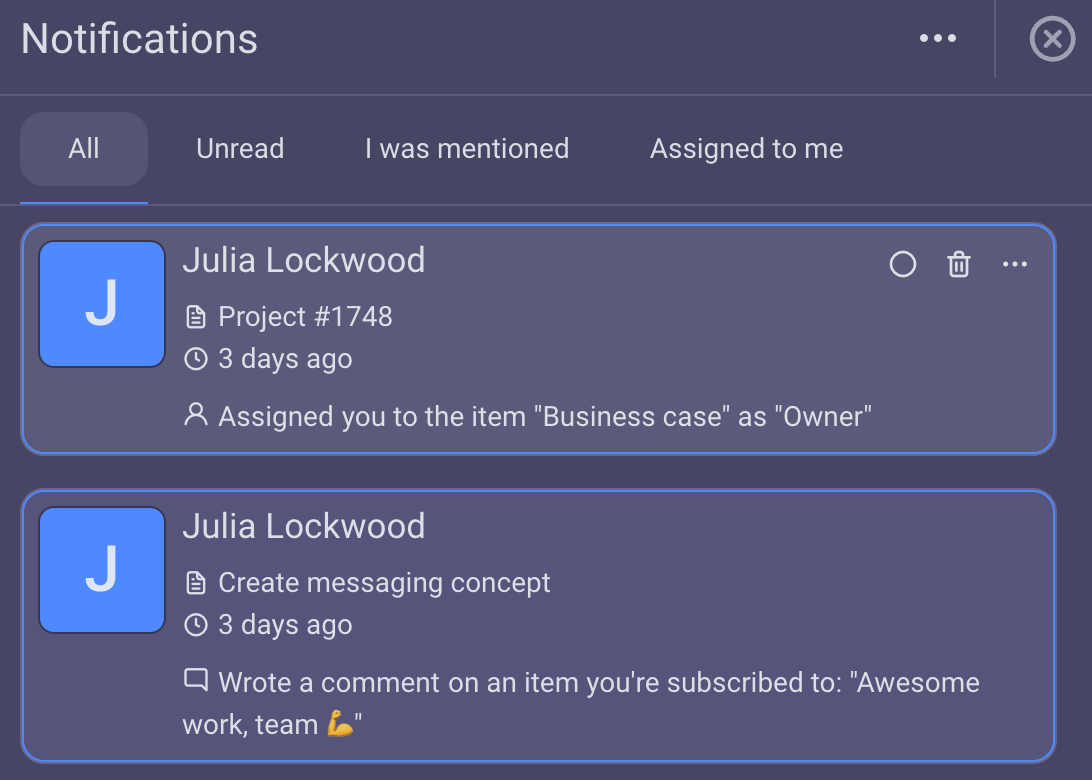What Is a Project Deadline?

Ever-present and ever-looming, deadlines are both the motivators that drive projects forward and a major cause of stress in the workplace.
Project management is especially sensitive to this dual nature of deadlines. That’s because project success, the organization’s reputation, and customer satisfaction are directly correlated to the teams’ ability to meet them.
But, deadlines aren’t always as rigid as they seem.
As a project manager, it’s your responsibility to ensure that all the necessary work is performed within the allotted timeframe.
As a good project manager, it’s your responsibility to recognize when that timeframe can be bent and molded in a way that benefits you and your team without hurting the overall well-being of the project.
This guide will:
- Cover the concept of a project deadline,
- Explain its usefulness and drawbacks,
- Explore ways that can help you stretch it to fit your goals, and
- Offer tips on how to be more successful at meeting them.
Table of Contents
What is a project deadline?
A project deadline is the latest date by which a project should be completed.
By definition, a project deadline should be a single date that, ideally, marks the end of the project.
However, people also use the word deadline to refer to any date throughout the project by which a certain chunk of the work is to be completed.
What project deadlines are NOT
There seems to be much confusion when it comes to the use of the following terms:
- Deadline,
- Due date, and
- Milestone.
While these are often used interchangeably, there are notable differences among them.
Deadline vs milestone
As we already said, a deadline is a date by which something should be completed. But, the word carries an ominous subtext.
A deadline also denotes a physical barrier around a prison beyond which escaped prisoners are liable to be shot.
Along a similar vein, the term deadline in project management implies serious, although not quite as deadly, consequences for those who don’t meet it.
A milestone, on the other hand, is a happy occasion. It marks a significant event in the course of a project that’s used to measure progress.
For example, a milestone can be submitting an important deliverable, such as a project plan, or getting your project scope approved.
But, it can also be something more tangible, like successfully releasing the alpha version of a piece of software, or launching a blog to support the product you’re developing via valuable content.
So, unlike the term “deadline”, “milestone” carries a positive connotation. While it can be a certain date, such as the first or last day of the project, it can also have its own deadline.
💡 Plaky Pro Tip
If you’re interested in learning more about project milestones, check out the following post on the subject:
Deadline vs due date
According to the International Project Management Association (IPMA), deadlines are imposed, while due dates are agreed upon.
As such, due dates are more realistic and put less pressure on the project team — which is why competent project managers should strive to establish due dates instead of deadlines wherever possible.
Why is a project deadline important?
The authors of a recent study on deadlines published in the Journal of Consumer Research concluded that the length of a deadline affects the perceived importance and urgency of a certain task.
In other words, when presented with two tasks, a large and important one that should be completed by the end of the month, and a smaller one due within a week, people will:
- Perceive the task with the longer deadline as less important and less urgent, and
- Postpone working on the task with the longer deadline as much as they can.
This is the case when deadlines are long. Imagine if there were no deadlines at all.
If Parkinson’s Law is to be believed, “work expands so as to fill the time available for its completion”. Theoretically then, if a timeframe is not determined, the work might expand indefinitely.
To avoid this, deadlines are there to keep us motivated, organized, and focused on what lies ahead.
How to set project deadlines
You will rarely have the luxury of choosing your own deadlines for project completion.
But, your ability to effectively organize the project schedule within its allotted timeframe is vital for project success.
Here’s how best to do it.
Tip #1: Prioritize
Considering the findings of the Journal of Consumer research study mentioned above, deadlines need to be prioritized to be effective.
When resources and time are limited, and thousands or even millions of dollars hinge on your ability to deliver, you can’t afford to assign deadlines arbitrarily and risk your team misreading their order of importance.
This doesn’t mean you should assign tight deadlines in order to force a sense of urgency, but simply arrange them so that the priorities are unambiguous.
Tip #2: Incorporate secret buffers
Regardless of how much time you spend planning your project and accounting for every possible project risk and issue you can think of, you’ll eventually realize that Murphy was right:
- Anything that can go wrong will go wrong,
- Nothing is as easy as it looks,
- Everything takes longer than you think.
This is why you should never plan for the best-case scenario.
Instead, incorporate sufficient buffers into your deadlines. This way, when the inevitable happens, you won’t be caught off guard and forced to break promises and sacrifice the quality of the product.
Tip #3: Avoid false deadlines
We’re not trying to send mixed signals here, we promise.
The buffers we mentioned above exist to add a bit more time to an already reasonable deadline to account for any possible mishaps.
Setting false deadlines, on the other hand, refers to driving your team to the point of exhaustion and burnout with unnecessarily short deadlines.
Of course, you won’t always have a choice. There will be times when external factors will force your hand in the matter.
But, driving your team hard when the stakes are low and there is little to be gained from finishing the project ahead of schedule causes nothing but chronic stress in the workplace that eventually leads to burnout.
Tip #4: Learn to say “No”
As a project manager, you’ll sometimes be in a position where determining the final project deadline will be entirely out of your control.
However, there will also be times when you’ll be able to buy yourself more time with some deft negotiating skills.
The key is to be assertive and unrelenting. Learn to say “No, that won’t do. I need more time.”, or even refuse the project altogether if you’re uncertain whether you’ll be able to meet the deadlines. But, in this case, be prepared to explain your reasons.
By bending to the will of the stakeholders who aren’t fully aware of what goes into managing a project, you’re doing everyone a disservice and virtually dooming your project from the get-go.
Tip #5: Recognize when to measure success against deadlines and when against milestones
Is your project externally or internally driven?
Are you using a Waterfall approach or an Agile approach?
Is the project tied to a certain date, or is the focus on quality over efficiency?
Once you get a broad picture of your project, you might realize that you don’t even need to set strict deadlines. Instead, you can measure success against important events and breakthroughs.
📖 The word “deadline” happens to mean the same thing in most use cases, but the same cannot be said for many project management terms. For example, the dictionary definitions of words such as “crashing”, “agile”, and “float” are different from how these words are understood in project management. To stay on top of PM terminology, you can refer to our Project Management Glossary of Terms.
How to meet deadlines
You’ve checked all the boxes, and you’re certain that you’ve set reasonable deadlines. But, now it’s time to start meeting them, and you don’t know where to start.
Here are a few tips to help you tackle deadlines with more confidence.
Tip #1: Break up the work into smaller chunks
You might be bored of hearing this advice already, but the reason you hear it so often is because it works.
Why?
Well, consider this project example and the answers to the following questions:
- If you were given a block of limestone and tasked with making a statue of a man holding a fish within the next three months, where would you even begin? And, what would happen if you accidentally made a mistake and had to start all over again?
Breaking a large project into smaller pieces gives you insight into how those pieces should be arranged and in what order. But, it also makes it easier to determine how much time and resources you’ll need to complete the entire project.
A project manager’s best friend for this kind of organizational feat is the Work Breakdown Structure, which visually divides the project into progressively smaller chunks.

💡 Plaky Pro Tip
In the guide below, you’ll find a detailed overview of the Work Breakdown Structure if you want to learn more about this useful project management tool:
Tip #2: Create a backup plan
The chances that everything will go smoothly in your project are slim to none. If you feel that a particularly important part of your project has a high chance of failure, make a plan B.
Most often, this will be the case with factors outside of your control.
Perhaps you’re having your supplies shipped from overseas, and there’s a chance they won’t make it in time. Or you’ve delegated part of your work to a new organization, and you don’t know what to expect.
Carefully assessing risks and making contingency plans just in case may end up saving your project in the long run.
Tip #3: Ask for more time
Research shows that people are afraid of asking for more time on their projects for fear of their superiors thinking badly of them. This is especially true with women, who are nearly two times less likely to ask for a deadline extension than men.
The truth of the matter is that no one is above asking for more time when they really need it. You can be sure that your superiors also do it. So, why should you be afraid to?
The key is to ask for help as soon as the need arises. If you wait too long in the hopes of covering up the issue, you might bring it up when it’s already too late.
Tip #4: Use software for managing deadlines
Sticky notes and whiteboards are a thing of the past.
With an increasing number of people working remotely and companies being more likely to hire people from across the globe, it’s important to be able to coordinate teams and keep everyone in the loop in order for work to flow smoothly.
The best way to do this is by using reliable project management software, such as Plaky.
With a tool that allows you to handle an unlimited number of teams, tasks, and users, you can easily:
- Assign and track deadlines,
- Check progress,
- Give feedback, and
- Receive notifications to always stay on top of your work in progress.
PM software also helps you improve transparency between teams and coworkers and makes it easier to coordinate multiple tasks and deadlines on larger projects.
With Plaky, you can create as many tasks as you want for each of your projects, and assign each of them a reasonable deadline.

It’s as easy as setting a due date and receiving a notification once it’s been completed, overdue, or when any other changes to the task have been made.

Your tasks can further be grouped into boards and spaces, or even broken down into subtasks and assigned to the right team members.
You can view your tasks in the form of a table or set them to Kanban view, or alternate between the two depending on how you prefer to organize work.
With a free and fully customizable project management tool such as Plaky, keeping up with your project timeline could be an absolute breeze.
Tip #5: Don’t strive for perfection
Make peace with the fact that perfection is unattainable and chasing it will rarely prove fruitful.
Anyone — whether your boss or your client — would be more pleased to see a working product finished on time than a nearly perfect product months or even years behind schedule.
Besides, chances are that your vision of perfection won’t match theirs. It’s a losing battle, so why wage it in the first place?
Instead, try the Pareto Principle, otherwise known as the 80/20 rule, which states that 80% of results will come from only 20% of the work.
So, rather than trying to perform all your tasks to perfection, focus your attention on the 20% of tasks that bring the most important outcomes.
While the math isn’t always perfect, the principle checks out. You’ll be able to achieve much more than you think by simply accepting that “good enough” is… well, good enough.
Tip #6: Identify soft spots/flexibilities
No matter how rigid the deadlines seem to be, a capable project manager should be able to identify flexibilities in a project and use them to their advantage.
Flexibilities, in this case, are parts of the project where tradeoffs can be made in exchange for more time or resources for a greater chance to meet the deadline.
For example, is the entire project time-sensitive, or can some less vital parts of the project be delivered after the final deadline?
Is it possible to delegate some of the work to a third party?
If an extension of the deadline is impossible, could a boost in resources be possible?
Simple questions like these could help you identify spots where you can make compromises that can turn your project from a chaotic mess to a stellar success.
💡 Plaky Pro Tip
For more tips on how to meet deadlines, check out this article:
Never miss another deadline — try Plaky today
As mentioned before, Plaky offers a great way to set and manage deadlines, as well as adapt to changing situations and improve your project management efficiency overall.
Moreover, Plaky offers affordable pricing on its paid plans, as well as an unmatched free plan that has all the core features some smaller teams may need.
Meanwhile, larger businesses might also be interested in the CAKE.com software suite, which bundles Plaky’s Enterprise plan with Clockify and Pumble, thus offering an all-in-one software package for project management, time management, and communication.
If you’re unsure whether Plaky is the right choice for your team, the best way to find out is to test it out for yourself. Simply sign up for a free account, and you’ll get access to all of Plaky’s features for 14 days. After this, you can continue using the Free plan indefinitely, or opt for whichever paid plan suits your needs best.
References
- Adams, T. et al. (2021). Mind the Workplace. Mental Health America. https://mhanational.org/sites/default/files/Mind%20the%20Workplace%20-%20MHA%20Workplace%20Health%20Survey%202021%202.12.21.pdf
- Goff, S. (2007). Tight, inflexible deadlines: Scourge of projects. International Project Management Association (IPMA). https://ipma-usa.org/articles/Deadlines.pdf
- Jaewon, Y., Whillans, A., and Donnelly, G. (2019, April 4). Why we don’t ask for more time on deadlines (But probably should). Harvard Business Review (HBR). https://hbr.org/2019/04/why-we-dont-ask-for-more-time-on-deadlines-but-probably-should
- Kruse, K. (2016, March 7). The 80/20 rule and how it can change your life. Forbes. https://www.forbes.com/sites/kevinkruse/2016/03/07/80-20-rule/?sh=17f92b43814b
- Murphy. (n.d.). Carnegie Mellon University. Retrieved June 1, 2022, from https://www.cs.cmu.edu/~fgandon/miscellaneous/murphy/
- Parkinson’s Law. (1955, November 19). The Economist. https://www.economist.com/news/1955/11/19/parkinsons-law
- Zhu, M., Bagchi, R., and Hock, J. S. (2018, April 5). The mere deadline effect: Why more time might sabotage goal pursuit. Journal of Consumer Research, 45(5), 1068-1084. https://academic.oup.com/jcr/article-abstract/45/5/1068/4962206?redirectedFrom=fulltext
 Project Management Hub
Project Management Hub 











